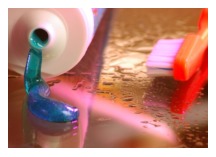Fluoride and Decay Prevention
 Fluoride is often called nature’s cavity fighter and for good reason. Fluoride, a naturally-occurring mineral, helps prevent cavities in children and adults by making the outer surface of your teeth (enamel) more resistant to the acid attacks that cause tooth decay.
Fluoride is often called nature’s cavity fighter and for good reason. Fluoride, a naturally-occurring mineral, helps prevent cavities in children and adults by making the outer surface of your teeth (enamel) more resistant to the acid attacks that cause tooth decay.
How Does Fluoride Protect Teeth?
Fluoride benefits both children and adults. Here’s how:
Before teeth break through the gums, the fluoride taken in from foods, beverages and dietary supplements makes tooth enamel (the hard surface of the tooth) stronger, making it easier to resist tooth decay. This provides what is called a “systemic” benefit.
After teeth erupt, fluoride helps rebuild (remineralize) weakened tooth enamel and reverses early signs of tooth decay. When you brush your teeth with fluoride toothpaste, or use other fluoride dental products, the fluoride is applied to the surface of your teeth. This provides what is called a “topical” benefit.
In addition, the fluoride you take in from foods and beverages continues to provide a topical benefit because it becomes part of your saliva, constantly bathing the teeth with tiny amounts of fluoride that help rebuild weakened tooth enamel.
How Do I Get Fluoride?
Drink Water with Fluoride
Fluoride is naturally found in most all water sources, rivers, lakes, wells and even the oceans. For the past 70 years, fluoride has been added to public water supplies to bring fluoride levels up to the amount necessary to help prevent tooth decay.
Community water fluoridation is like drinking milk fortified with Vitamin D or eating bread and cereals enriched with folic acid. Before water fluoridation, children had about three times as many cavities. Because of the important role it has played in the reduction of tooth decay, the Centers for Disease Control and Prevention has proclaimed community water fluoridation one of ten great public health achievements of the 20th century. Studies prove water fluoridation continues to help prevent tooth decay by at least 25% in children and adults, even with fluoride available from other sources, such as toothpaste. Today, almost 75 percent of the U.S. population is served by fluoridated community water systems.
Use Toothpaste and Mouthrinse with Fluoride
Toothpaste with fluoride has been responsible for a significant drop in cavities since 1960. Look for one with the ADA Seal of Acceptance to make sure it contains fluoride.
- Brush twice a day (morning and night) or as directed by your dentist and physician.
- For children younger than 3 years, start brushing their teeth as soon as they start to appear in the mouth by using fluoride toothpaste in an amount no more than a smear or the size of a grain of rice.
- For children 3 to 6 years old, use no more than a pea-sized amount of fluoride toothpaste.
- Always supervise your child’s brushing to make sure they use the right amount and try to get your child to spit out most of the toothpaste.
Mouthwash with fluoride can help make your teeth more resistant to decay, but children six years or younger should not use it unless it’s been recommended by a dentist. Many children younger than 6 are more likely to swallow it than spit it out because their swallowing reflexes aren’t fully developed.
Visit Your Dentist for a Professional Application
If you have a good chance of getting cavities, your dentist can apply fluoride directly to your teeth during your dental visit with a gel, foam or rinse.
Take a Fluoride Supplement
Available by prescription only, fluoride supplements come in tablet, drop or lozenge forms. They are recommended only for children ages six months to 16 years living in areas without adequate amounts of fluoride in their community drinking water and who are at high risk of developing cavities. Talk to your dentist, pediatrician or family physician about your child’s specific fluoride needs.
If you have any questions regarding the use of Fluoride, please call our office, we will be happy to help.
Schedule Your Appointment
Thank you for choosing us to be your dental health care providers in Pawtucket. Following a good oral hygiene routine and receiving regular dental check ups are ways to keep your healthy smile.